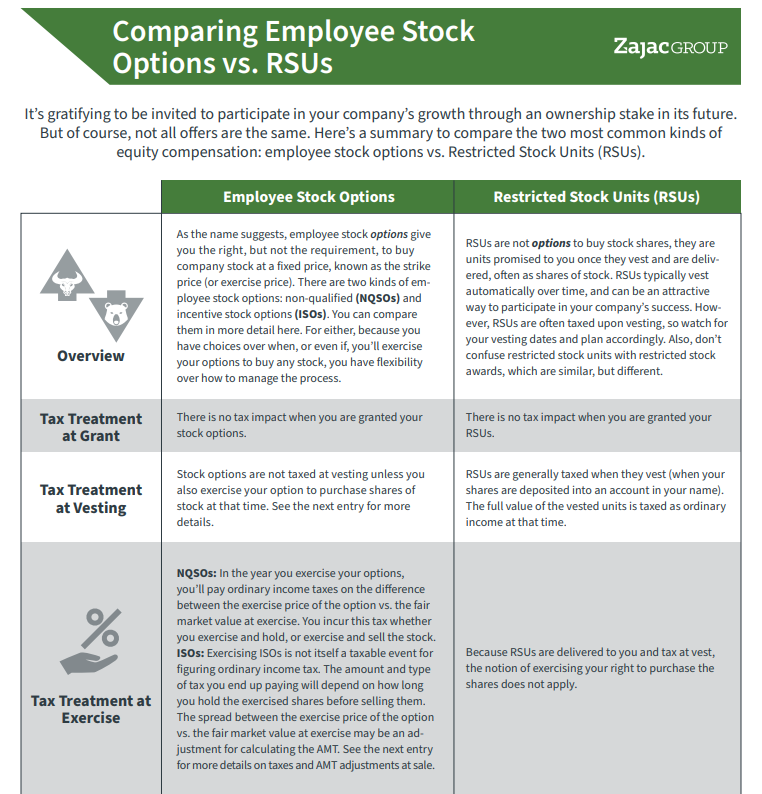
Answering the question of “when” — when to exercise, and when to sell — is wrapped in complexity. With so many liquidation strategies at your disposal and so many personal needs to consider (such as what kind of stock options you own and what the tax implications may be for taking action with them), the decision-making web can seem endless and overwhelming.
But there is one approach that can make everything much simpler: exercise all your options and sell all your shares immediately.
No tax planning, no worries about the future value of the stock or what you may be “missing,” no holding period requirements that keep you invested longer than your intentions.
Just exercise and sell everything.
The result? You transfer value in your employee stock options into cash proceeds that can be used to fund your financial planning goals and objectives immediately.
COMPARISON GUIDE
Not All Stock Offers are the Same! Here's a helpful comparison between two of the most common employee stock options.
It sounds simple and straightforward enough. But is this the strategy for you? A good start to discovering the right answer is to educate yourself on the positives and negatives of this strategy. Here’s what you need to know.
Advantages of Liquidating Your Employee Stock Options Right Now
The most notable advantage to an immediate exercise and sale of all your employee stock options is that you transfer the imbedded value of your employee stock option into cash. In other words, you transform paper value into real value via cash you can use right now.
The best use of this cash might be to reinvest it in the market through a more diversified portfolio. You could also use it to fund specific savings goals. Or, depending on your financial situation and plan, it might be appropriate to use this money right away in other areas of your life.
A second benefit of the exercise-and-sell-immediately strategy is the ability to diversify your assets. We touched on this above, but it’s worth digging into more detail to understand what happens when you hold instead of sell.
A large position in a single company stock exposes you to concentration risk. With concentration risk, you retain the possibility that the value of your stock options can swing drastically in a short period of time.
If you exercise and sell, you remove the inherent volatility associated with concentration risk. And again, you can then use the proceeds to invest through a better diversified, more strategic investment portfolio.
While diversification does not guarantee protection from market volatility or investment loss, it’s generally accepted that a diversified portfolio will lessen the volatility of your investment portfolio.
A final advantage of the exercise-and-sell-it-all strategy? Certainty. A bird in the hand is better than two in the bush, after all.
If you exercise and sell, you know what you the final outcome of your transaction will be. No more guessing, projecting, or hoping for a future value of your stock options. No more seeing the value of your employee stock option statement change.
When you exercise and sell, you know the exercise price, you know the market price when you exercise (or hopefully very close to it), and you know the final sale price (or very close to it). Therefore, you know what will you get once that transaction is complete.
Certainty is intangible, but that doesn’t mean it can’t be of great value when it comes to building wealth.
Disadvantages of an Immediate Exercise and Sale Strategy for Employee Stock Options
When you exercise and sell your employee stock options, the transaction is taxable and reportable on the calendar year’s tax return in which the transition occurred. Any profit you realize will be taxed as ordinary income.
Ordinary income receives no preferential tax treatment and is taxed at the highest marginal tax rate — which could be a potential downside when it comes to exercising and selling all of your options and subsequent shares.
If you have a lot of profit potential in your employee stock options, receiving that profit after implementing this strategy could push you into a higher tax bracket. All else being equal, a higher tax bracket means more tax owed and less money in your pocket.
Essentially, you lose some tax efficiency when you exercise and sell everything all at once. In some cases, you could pay less in taxes if you use a different approach and exercise and sell your stock options over a period of time.
But the most tax efficient strategy isn’t necessarily the best one, depending on your specific circumstances.
You should talk to an advisor with experience in both leveraging stock options and understanding tax planning to run the numbers. Then, compare various strategies available to you. You’ll want to evaluate what leaves the most money in your pocket, of course — but you also need to consider pros, cons, and trade-offs.
Another disadvantage of exercising and selling immediately is one that specifically pertains to incentive stock options: you will not get to perform a qualifying disposition. Again, this is a tax-related issue.
It means you won’t be able to take advantage of the lower tax rates you may get if you exercised, then held shares and sold them later. This isn’t a reason to automatically rule out the exercise-and-sell-immediately strategy — but it is something to keep in mind and weigh alongside all the other factors that will impact your decision.
Thinking Through the Unknowns: What About the Future Value of Your Options?
If you exercise and sell your employee stock options, you also forego the upside potential of your company stock. Holding employee stock options affords you the opportunity to participate in potential price appreciation of the shares.
An appreciating stock price is certainly not guaranteed — and the volatile path the stock might take on its way to higher value might not be an experience you can emotionally handle — but it is possible that you can make a lot of money by staying invested.
And it’s also possible you lose a lot of money, too. While it’s worth considering the potential future value of company stock before you decide what strategy you want to use, you can’t base your entire decision around what to do on this alone because you simply don’t know what will happen.
There’s Leverage to Think About, Too
In addition to giving up on maybe getting a bigger gain in the future, selling everything now also means you give up leverage. Leveraging your stock options may allow for your growth to be more than the actual growth in a stock price, as a percentage basis.
Here’s what that means: If you have 10,000 stock options with a grant price of $10 per share and a current market price of $20 per share. then the value of your employee stock options is $100,000.
Value = Number of Shares * (Current Price – Exercise Price)
= 10,000 * (20 – 10)
=$100,000
To illustrate leverage, we can adjust market price of the stock in 20% increments and calculate the value of the employee stock options
| Stock Price | % Change of Stock | Change in ESO Value | Increase in Value |
| $16.00 | -20% | $40,000 | -40.00% |
| $20.00 | 0% | $0 | 0.00% |
| $24.00 | 20% | $40,000 | 40.00% |
| $28.80 | 20% | $48,000 | 34.28% |
| $34.56 | 20% | $57,600 | 30.64% |
As the price of the stock moves by 20%, you can see the value of the stock options increases by significantly more. When the stock price increase from $20 to $24 per share, a 20% increase, the value of the stock options increase by 40,000, or 40%.
Again, you can’t base your decision on whether to exercise and sell everything immediately solely on something like this. But it’s worth considering and making a part of the conversation around what you should do with your options.
A Few Good Reasons to Exercise and Sell
It’s easy to write about the advantages and disadvantages of an immediate exercise and sell, but how do you incorporate this into practical decision making?
One compelling reason to exercise and sell everything right now is if the after-tax proceeds of the transaction will give you enough money to meet all your financial planning goals and objectives.
Once you have “enough,” isn’t that good enough?
A second reason to exercise and sell immediately is if you are risk averse and cannot handle the volatility of a single stock position.
A single stock position can move severely in a short period of time. As it does, the value of your employee stock options can more even more as illustrated above with leverage.
If you are not comfortable with the big swings, exercising and selling everything right now might be right for you so you can take advantage of a big benefit of that strategy: certainty.
A third reason to exercise and sell would be if you consider the stock to be fairly valued, and you believe it will go down in the future.
While predicting where a stock price will go is difficult and no one can be sure, a strong conviction and the subsequent desire to act upon this may warrant an exercise and sell. This would allow you to capture the current value of the options before it is wiped away by a falling stock price.
What’s Next?
A single exercise and sell strategy is one that strips away the complexity that can potentially inhibit your ability to make a decision. By simplifying the decision-making tree, you may feel more confident about taking action — and you know you’re choosing the strategy that will immediately put real money in your pocket.
This strategy is simple, straightforward, and you know what you are going to get as a result.
For this reason, it’s worth considering starting your decision-making process by comparing your other options to the sell and exercise immediately strategy. Using this as the base case, you can more adequately weight both the benefits and drawbacks of other advanced planning techniques.
What you may find upon careful inspection and comparison is that the bird in the bush isn’t quite as attractive as it might seem.
This material is intended for informational/educational purposes only and should not be construed as investment, tax, or legal advice, a solicitation, or a recommendation to buy or sell any security or investment product. Hypothetical examples contained herein are for illustrative purposes only and do not reflect, nor attempt to predict, actual results of any investment. The information contained herein is taken from sources believed to be reliable, however accuracy or completeness cannot be guaranteed. Please contact your financial, tax, and legal professionals for more information specific to your situation. Investments are subject to risk, including the loss of principal. Because investment return and principal value fluctuate, shares may be worth more or less than their original value. Some investments are not suitable for all investors, and there is no guarantee that any investing goal will be met. Past performance is no guarantee of future results. Talk to your financial advisor before making any investing decisions.







0 Comments